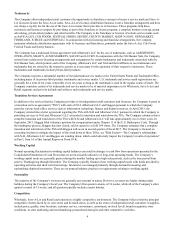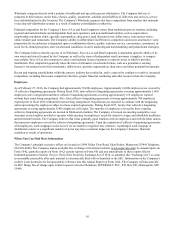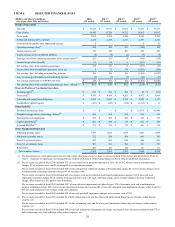Albertsons 2016 Annual Report Download - page 21
Download and view the complete annual report
Please find page 21 of the 2016 Albertsons annual report below. You can navigate through the pages in the report by either clicking on the pages listed below, or by using the keyword search tool below to find specific information within the annual report.19
Industry Data Security Standard (“PCI DSS”), issued by the PCI Council. PCI DSS contains compliance guidelines and
standards with regard to the Company’s security surrounding the physical and electronic storage, processing and transmission
of individual cardholder data. By accepting debit cards for payment, the Company is also subject to compliance with American
National Standards Institute data encryption standards and payment network security operating guidelines. The payment card
industry set October 1, 2015 as the date on which it began to shift liability for certain transactions to retailers who are not able
to accept Europay, MasterCard, and Visa (EMV) transactions. The Company expects to implement the EMV technology in
calendar year 2016. As a result, before the implementation of the EMV technology, the Company may be liable for costs
incurred by payment card issuing banks and other third parties or subject to fines and higher transaction fees. As a result of the
intrusions, the Company engaged a new third-party security firm to provide the Company a report on compliance with PCI
DSS. This transition of security firms delayed the Company’s receipt of its report on PCI DSS compliance. On June 30, 2015,
the Company received its merchant report on compliance and on September 30, 2015, the Company received its service
provider report on compliance with respect to PCI DSS version 3.1.
Despite any certifications and the utilization of other information security measures, the Company cannot be certain that all of
its information technology ("IT") systems or the IT systems of its vendors operate properly or will be able to prevent, contain or
detect any future cyber-attacks or security breaches from known malware, malware that may be developed in the future or
otherwise. Cyber-attacks are rapidly evolving and becoming increasingly sophisticated and difficult to detect, and therefore, the
Company may be unable to anticipate these attacks or implement adequate preventive measures. Additionally, unauthorized
parties may attempt to gain access to the Company’s or a vendor’s systems or facilities through fraud, trickery or other forms of
deception involving the Company’s employees or vendors. To the extent that any attack or breach results in the loss, damage or
misappropriation of information, the Company may be adversely affected by claims from customers, financial institutions,
payment card brands, stockholders and others and by costly inquiries or enforcement actions on the part of regulatory
authorities. The Company’s operations could also be significantly disrupted by these claims, as well as by the need to spend
significant time and resources/funds to upgrade, fix or replace its systems. The Company could also lose credibility with its
customers and suffer damage to its reputation and future sales, including through negative publicity and social media. In
addition, the cost of complying with stricter privacy and information security laws and standards, including PCI DSS version
3.1, and developing, maintaining and upgrading technology systems to address future advances in technology, could be
significant and the Company could experience problems and interruptions associated with the implementation of new or
upgraded systems and technology or with maintenance or adequate support of existing systems.
Worsening economic conditions could adversely impact consumer spending, increase costs of doing business or
otherwise adversely affect the Company’s operating results.
The vast majority of the Company’s operations and customers are located in the United States, making its results highly
dependent on U.S. consumer confidence and spending habits. In recent economic cycles, the U.S. economy has experienced
economic recession, higher unemployment rates, higher energy costs, higher insurance and healthcare costs, a decline in the
housing market, and greater restrictions on the availability of credit, all of which contributed to reduced consumer confidence
and increased price competition.
While the U.S. economy and consumer confidence have improved recently, the sustainability of these improvements remains
uncertain. There can be no assurance that the Company will be able to identify and respond to changes and trends in consumer
spending and preferences and/or maintain the competitive position of its operations. Additionally, these economic factors, along
with higher interest rates, costs of labor and tax rates, and other changes in tax, healthcare and other laws and regulations, can
increase the Company’s cost of sales and selling, general and administrative expenses, and otherwise adversely affect the
Company’s operating results.
Changes in commodity prices, including due to inflation or deflation, and availability of commodities may affect the
Company’s financial condition and operating results.
Many products the Company sells include ingredients such as wheat, corn, oils, milk, eggs, sugar, cocoa and other
commodities. In addition, the Company purchases and uses significant quantities of packaging materials to package its
products and energy for its distribution centers, stores and offices. Prices for these raw materials, other supplies and energy are
volatile and can fluctuate due to conditions that are difficult to predict. These conditions include global competition for
resources, currency fluctuations, political conditions, severe weather, the potential longer-term consequences of climate change
on agricultural productivity, crop disease or pests, water risk, health pandemics, consumer or industrial demand, and changes in
governmental trade, alternative energy and agricultural programs.
We believe the Company’s Save-A-Lot segment is impacted to a greater degree by inflation and deflation than traditional
grocery formats due to product mix, its edited assortment of products and product sourcing on private-label products.
























